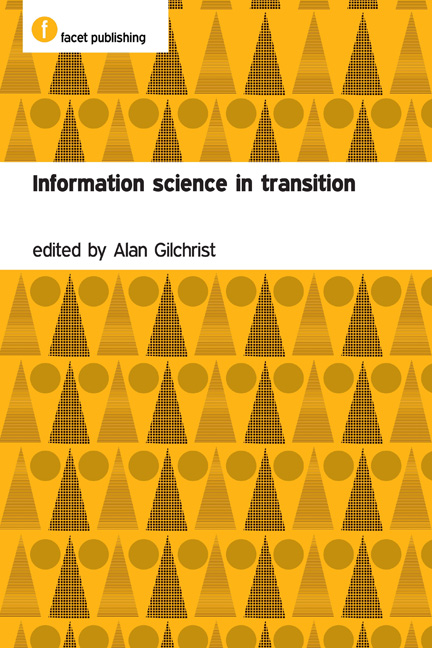Book contents
- Frontmatter
- Contents
- Contributors
- Preface
- Editorial
- Guest Editorial: Meeting the challenge
- 1 Fifty years of UK research in information science
- 2 Smoother pebbles and the shoulders of giants: the developing foundations of information science
- 3 The last 50 years of knowledge organization: a journey through my personal archives
- 4 On the history of evaluation in IR
- 5 The information user: past, present and future
- 6 The sociological turn in information science
- 7 From chemical documentation to chemoinformatics: 50 years of chemical information science
- 8 Health informatics: current issues and challenges
- 9 Social informatics and sociotechnical research – a view from the UK
- 10 The evolution of visual information retrieval
- 11 Information policies: yesterday, today, tomorrow
- 12 The disparity in professional qualifications and progress in information handling: a European perspective
- 13 Electronic scholarly publishing and Open Access
- 14 Social software: fun and games, or business tools?
- 15 Bibliometrics to webometrics
- 16 How I learned to love the Brits
- Index
14 - Social software: fun and games, or business tools?
Published online by Cambridge University Press: 08 June 2018
- Frontmatter
- Contents
- Contributors
- Preface
- Editorial
- Guest Editorial: Meeting the challenge
- 1 Fifty years of UK research in information science
- 2 Smoother pebbles and the shoulders of giants: the developing foundations of information science
- 3 The last 50 years of knowledge organization: a journey through my personal archives
- 4 On the history of evaluation in IR
- 5 The information user: past, present and future
- 6 The sociological turn in information science
- 7 From chemical documentation to chemoinformatics: 50 years of chemical information science
- 8 Health informatics: current issues and challenges
- 9 Social informatics and sociotechnical research – a view from the UK
- 10 The evolution of visual information retrieval
- 11 Information policies: yesterday, today, tomorrow
- 12 The disparity in professional qualifications and progress in information handling: a European perspective
- 13 Electronic scholarly publishing and Open Access
- 14 Social software: fun and games, or business tools?
- 15 Bibliometrics to webometrics
- 16 How I learned to love the Brits
- Index
Summary
Abstract
This is the era of social networking, collective intelligence, participation, collaborative creation, and borderless distribution. Every day we are bombarded with more publicity about collaborative environments, news feeds, blogs, wikis, podcasting, webcasting, folksonomies, social bookmarking, social citations, collaborative filtering, recommender systems, media sharing, massive multiplayer online games, virtual worlds, and mashups. This sort of anarchic environment appeals to the digital natives, but which of these so-called ‘Web 2.0’ technologies are going to have a real business impact? This paper addresses the impact that issues such as quality control, security, privacy and bandwidth may have on the implementation of social networking in hide-bound, large organizations.
Introduction
Fifty years ago information was stored on punch cards. SDI services appeared about 10 years later and databases were available online from about 1978. In 1988 PCs were in common use and by 1998 the web was being used as a business tool. The web of the 1990s might be thought of as ‘Web 1.0’, for now in 2008 there is much hype about Web 2.0, but what does that mean? Web 2.0 is an umbrella term for a number of new internet services that are not necessarily closely related. Indeed, some people feel that Web 2.0 is not a valid overall title for these technologies. A reductionist view is that of a read–write web and lots of people using it. Tim O'Reilly and colleagues [1] introduced the term in 2004 and later produced a report refining the concept [2].
O'Reilly defines eight core patterns of Web 2.0:
Harnessing collective intelligence
Data as the next ‘Intel Inside’
Innovation in assembly
Rich user experiences
Software above the level of a single device
Perpetual beta
Leveraging [sic] the long tail
Lightweight software and business models and cost effective scalability.
He expands on these patterns as follows. Harnessing collective intelligence is sometimes described as the core pattern of Web 2.0; it describes architectures of participation [3] that embrace the effective use of network effects and feedback loops to create systems that get better the more that people use them. The second core pattern above is jargon for the fact that information has become as important as, or more important than software, since software itself has become a commodity.
- Type
- Chapter
- Information
- Information Science in Transition , pp. 323 - 346Publisher: FacetPrint publication year: 2009



